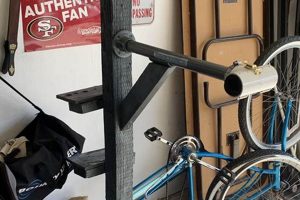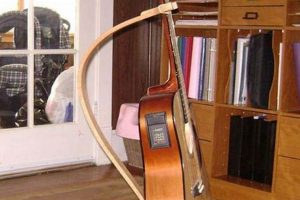A self-constructed platform, typically from timber, serves as a base for elevating objects from the ground. These supports can be tailored to specific dimensions and load-bearing requirements, offering a versatile solution for a range of applications from displaying plants to organizing tools.
The advantages of crafting such a support structure oneself include cost savings compared to purchasing pre-made alternatives, complete customization to suit individual needs, and the inherent satisfaction derived from hands-on creation. Historically, individuals have utilized timber to create these foundational elements due to its accessibility and relative ease of manipulation using basic tools.
The following sections will delve into the various design considerations, material selections, and assembly techniques involved in creating a durable and aesthetically pleasing elevated base, emphasizing practical application and long-term usability.
Essential Guidance for Constructing a Timber Platform
The following guidelines are crucial for ensuring the structural integrity, longevity, and aesthetic appeal of a self-made timber support structure. Attention to detail during each phase is paramount.
Tip 1: Material Selection. Choose lumber appropriate for the intended load. Consider hardwood options like oak or maple for heavy items; softwood varieties such as pine or fir may suffice for lighter applications. Pressure-treated lumber is recommended for outdoor use to resist decay.
Tip 2: Precise Measurements. Accurate dimensions are critical. Account for the object the structure will support, allowing sufficient clearance and stability. Double-check all measurements before cutting any material.
Tip 3: Secure Joinery. Employ robust joinery techniques, such as screws, dowels, or mortise and tenon joints, to ensure structural soundness. Apply wood glue liberally to strengthen connections and prevent movement over time.
Tip 4: Leveling the Base. Confirm that the structure is perfectly level. Uneven surfaces can cause instability and premature failure. Use shims as needed to achieve a stable and balanced platform.
Tip 5: Protective Finishing. Apply a sealant or finish to protect the wood from moisture, UV radiation, and abrasion. This will prolong the lifespan of the structure and enhance its aesthetic appeal. Exterior-grade finishes are essential for outdoor applications.
Tip 6: Weight Distribution. Consider the distribution of weight on the platform. Reinforce areas that will bear the most load to prevent warping or collapse. Consider adding additional support structures as needed.
Tip 7: Safety Precautions. Always wear appropriate safety gear, including eye protection and gloves, when working with power tools. Ensure adequate ventilation when applying finishes and follow all manufacturer’s instructions.
Adhering to these guidelines will significantly enhance the quality and durability of a self-constructed timber support, yielding a reliable and aesthetically pleasing solution for various needs.
The subsequent sections will provide detailed instructions on specific design options and advanced assembly techniques.
1. Material Selection
Material selection represents a foundational decision point in the construction of any wooden platform. The choice of wood directly impacts the structure’s strength, durability, aesthetic appeal, and suitability for its intended application.
- Load-Bearing Capacity and Wood Density
The density of the chosen wood species correlates directly with its load-bearing capacity. Hardwoods, such as oak or maple, possess a higher density and are therefore appropriate for supporting heavier objects. Softwoods, like pine or fir, are suitable for lighter loads but may require reinforcement to prevent deflection or structural failure under significant weight.
- Environmental Resistance and Wood Treatment
For applications exposed to the elements, such as outdoor plant stands, the wood’s inherent resistance to moisture, decay, and insect infestation is critical. Pressure-treated lumber is specifically engineered to resist these factors, significantly extending the lifespan of the structure. Untreated lumber, when used outdoors, necessitates protective coatings or sealants to mitigate environmental damage.
- Aesthetic Considerations and Grain Pattern
The grain pattern and color of the wood contribute significantly to the visual appeal. Different species offer varying aesthetic qualities, from the uniform grain of pine to the distinctive figuring of cherry or walnut. The chosen wood should complement the surrounding environment and the object it supports.
- Workability and Tooling Requirements
The ease with which a particular wood can be cut, shaped, and joined affects the complexity of the construction process. Softwoods are generally easier to work with using hand tools, while hardwoods may require specialized power tools and techniques. The chosen material should align with the builder’s skill level and available resources.
Ultimately, the selection of wood represents a series of trade-offs between cost, strength, durability, aesthetics, and workability. Careful consideration of these factors is essential to creating a wooden platform that is both functional and visually pleasing.
2. Design Customization
Design customization, within the context of a self-made wooden platform, represents the intentional tailoring of the structure’s dimensions, form, and features to precisely meet a specific set of requirements. The degree of customization directly impacts the platform’s functional suitability and aesthetic integration within its intended environment. This deliberate modification contrasts sharply with the limitations imposed by mass-produced, commercially available alternatives. For instance, a bespoke platform for displaying a particular piece of art might necessitate a specific height, width, and angle to optimize viewing, whereas a generic platform would likely compromise one or more of these factors. The act of customizing directly addresses the limitations of standardized solutions.
The practical significance of understanding this relationship lies in the potential for enhanced problem-solving and resource optimization. A tailored wooden platform, designed with specific weight-bearing constraints, material limitations, and environmental factors in mind, often proves more structurally sound and cost-effective than adapting a pre-existing, less suitable option. Consider a scenario involving the support of specialized laboratory equipment. Precise dimensional requirements and vibration dampening characteristics are crucial. A customized platform, built with specific materials and construction techniques, provides a safer and more reliable solution. The ability to adjust designs to accommodate unique constraints is paramount.
In summary, design customization is not merely an aesthetic consideration but a critical element determining the effectiveness and efficiency of a self-constructed wooden platform. The capacity to tailor the structure directly addresses limitations inherent in standardized solutions and facilitates the creation of a support system optimized for its intended purpose. This approach enhances both the functional utility and the long-term value of the project, while requiring a higher investment of planning and execution.
3. Structural Integrity
Structural integrity constitutes a foundational requirement for any self-constructed wooden platform. The ability of the structure to withstand applied loads and environmental stresses without deformation or failure dictates its suitability for the intended purpose. Achieving adequate structural integrity necessitates a comprehensive understanding of material properties, joinery techniques, and load distribution principles.
- Material Strength and Stiffness
The inherent strength and stiffness of the chosen wood species directly impact the platform’s load-bearing capacity. Hardwoods, such as oak or maple, offer superior resistance to bending and compression compared to softwoods like pine or fir. Selection of an appropriate wood type, coupled with proper dimensioning, is crucial for ensuring structural stability. For example, a platform intended to support heavy machinery requires a higher-density wood with a larger cross-sectional area than one designed for lighter items.
- Joinery Techniques and Load Transfer
The effectiveness of the joinery techniques used to assemble the platform plays a significant role in transferring loads between individual components. Robust joinery methods, such as mortise and tenon joints or screwed connections with glue, distribute stress more evenly and prevent premature failure. Inadequate joinery can result in localized stress concentrations and subsequent structural weakness. Imagine a platform with poorly secured legs; it would be prone to collapsing under even moderate weight.
- Load Distribution and Support Placement
The manner in which the load is distributed across the platform directly affects the stresses experienced by its individual components. Evenly distributing the load minimizes stress concentrations and prevents localized deformation. Strategic placement of support structures, such as legs or internal bracing, can further enhance load distribution and improve overall stability. A platform with unevenly spaced supports would be more susceptible to sagging or collapse under load.
- Environmental Factors and Material Degradation
Environmental factors, such as moisture and temperature fluctuations, can degrade the structural integrity of wood over time. Exposure to moisture promotes decay and weakens the wood fibers, while temperature changes can cause expansion and contraction, leading to joint loosening. Implementing protective finishes and selecting weather-resistant materials are essential for mitigating the effects of environmental degradation, particularly in outdoor applications. A wooden platform left untreated and exposed to the elements will inevitably suffer from structural deterioration.
These facets of structural integrity are inextricably linked in the construction of a “diy wood stand”. Neglecting any one aspect can compromise the overall stability and longevity of the platform, rendering it unsuitable for its intended purpose. A properly designed and constructed wooden platform, however, provides a stable and reliable support solution for a wide range of applications, demonstrating the importance of prioritizing structural integrity throughout the construction process.
4. Joint Strength
Joint strength, within the context of a self-constructed timber support structure, represents a critical determinant of overall structural integrity and long-term durability. It directly relates to the ability of the constructed stand to withstand applied loads without experiencing deformation or catastrophic failure at the connection points between individual wooden components. The selection of appropriate jointing methods and the quality of their execution directly impact the load-bearing capacity and service life of the resulting structure. Inadequate joint strength constitutes a primary cause of structural failure in such projects, rendering the assembly unstable and unsafe for its intended purpose. A poorly constructed joint, for example, might separate under load, causing a shelf to collapse or a supporting leg to buckle. Conversely, robust and well-executed joints distribute stress effectively and ensure the stability of the entire structure.
Practical applications of this understanding are readily apparent in various timber platform designs. For instance, a heavy-duty plant stand intended for outdoor use demands strong, weather-resistant joints. Mortise and tenon joints, secured with waterproof adhesive and further reinforced with screws or dowels, provide superior resistance to both mechanical stress and environmental degradation compared to simple butt joints. Similarly, a tool storage platform in a workshop benefits from employing dovetail joints, which offer exceptional resistance to tensile forces and prevent racking. The deliberate selection of jointing techniques based on anticipated load conditions and environmental factors is a prerequisite for constructing durable and reliable support structures. Without proper attention to joint strength, the entire assembly becomes a potential point of failure.
In summary, joint strength is an indispensable characteristic of a “diy wood stand,” directly influencing its stability, safety, and longevity. The careful selection and execution of appropriate jointing techniques, taking into account the anticipated loads and environmental conditions, are paramount. Prioritizing joint strength in the design and construction process ensures that the resulting structure can reliably fulfill its intended function, mitigating the risks associated with structural failure and extending its useful lifespan. The investment in time and skill to create robust joints is crucial for realizing a stable and durable elevated timber base.
5. Surface Finishing
Surface finishing, in the context of self-assembled wooden platforms, represents a critical step that directly impacts the structure’s aesthetics, durability, and overall service life. It encompasses a range of treatments applied to the wood surface to provide protection, enhance visual appeal, and improve usability. The selection and application of appropriate finishing techniques are essential for maximizing the value and longevity of the wooden structure.
- Protection Against Environmental Factors
Surface finishes serve as a barrier against moisture, ultraviolet radiation, and other environmental factors that can degrade wood over time. Sealants, paints, and varnishes prevent water absorption, which can lead to swelling, warping, and rot. UV-resistant coatings protect against fading and discoloration caused by sunlight. Exterior-grade finishes are particularly important for platforms intended for outdoor use, ensuring long-term durability and resistance to weathering.
- Enhancement of Aesthetic Appeal
Surface finishes can significantly enhance the visual appeal of wooden platforms, accentuating the natural grain patterns and adding depth and richness to the wood. Stains are used to alter the color of the wood, allowing it to blend seamlessly with its surroundings or to create a contrasting visual element. Clear finishes, such as varnish or lacquer, provide a protective layer while allowing the natural beauty of the wood to shine through. The choice of finish can transform a simple wooden platform into a visually striking piece of furniture or decor.
- Improved Usability and Cleanability
Surface finishes can improve the usability and cleanability of wooden platforms by creating a smooth, non-porous surface that is resistant to stains and dirt. Polyurethane coatings, for example, provide a durable and easy-to-clean surface that is ideal for platforms used in workshops or kitchens. Oiled finishes, while less durable than polyurethane, offer a natural look and feel and can be easily renewed with periodic reapplication. A properly finished platform is not only more aesthetically pleasing but also more practical and functional.
- Prevention of Splintering and Injury
Surface finishing plays a role in safety by smoothing rough edges and preventing splintering. Sanding is a crucial step in preparing the wood for finishing, removing any sharp edges or imperfections that could cause injury. Fillers can be used to fill any cracks or voids in the wood surface, creating a smooth and even surface. A properly finished platform is safer to handle and use, minimizing the risk of splinters and other injuries.
These aspects of surface finishing are essential for producing a high-quality and durable self-made wooden platform. By carefully selecting and applying appropriate finishing techniques, one can significantly enhance the aesthetics, longevity, and functionality of the structure. A well-finished platform not only looks better but also performs better, providing a stable and reliable support solution for a variety of applications.
6. Weight Capacity
Weight capacity is a primary consideration in the design and construction of any self-made wooden platform. It dictates the structural requirements of the assembly and directly influences its suitability for the intended application. Understanding the relationship between material properties, structural design, and anticipated load is crucial for ensuring the safety and longevity of the platform.
- Material Selection and Load-Bearing Capability
The choice of wood species directly determines the platform’s ability to withstand applied loads. Hardwoods, such as oak and maple, possess higher compressive and flexural strengths compared to softwoods like pine and fir, making them suitable for supporting heavier objects. The selected material must exhibit sufficient strength to resist deformation or failure under the anticipated weight. For instance, a platform intended for supporting heavy machinery necessitates a hardwood construction with appropriate dimensions.
- Structural Design and Load Distribution
The design of the platform influences how weight is distributed across its various components. Elements such as support placement, bracing, and the use of cross-members play a crucial role in transferring loads effectively. Adequate support is essential to prevent sagging or collapse under heavy weight. Consider a platform with legs positioned only at the corners; it would likely buckle under a concentrated load in the center. Conversely, strategically placed supports enhance load distribution and increase overall weight capacity.
- Joinery Strength and Connection Integrity
The strength of the joints connecting individual wooden members is paramount for ensuring the platform’s structural integrity under load. Robust joinery techniques, such as mortise and tenon joints, dovetails, or screwed connections with adhesive, provide superior resistance to shear and tensile forces compared to weaker methods like simple butt joints. Weak joints can become points of failure, limiting the platform’s overall weight capacity. The use of inadequate fasteners or poorly executed joinery can compromise the entire structure.
- Safety Factors and Anticipated Usage
It is prudent to incorporate a safety factor into the design to account for potential overloads or unexpected stresses. The anticipated usage of the platform should be carefully considered, including the maximum weight it will likely bear and the frequency of loading and unloading. A platform intended for constant heavy use requires a higher safety factor than one designed for occasional light loads. Overestimating the anticipated weight is always preferable to underestimating it. Designing for a 25% higher weight capacity than what is expected would provide a crucial safety margin.
The facets presented underscore the integral role weight capacity plays in the planning and construction of a “diy wood stand”. By carefully considering material properties, structural design, joinery strength, and safety factors, the builder can ensure that the platform is capable of safely and reliably supporting its intended load. Attention to these factors not only enhances the safety and longevity of the structure but also ensures its overall functionality and value.
7. Dimensional Accuracy
Dimensional accuracy, in the construction of a “diy wood stand,” represents the degree to which the actual measurements of the component pieces and the assembled structure align with the intended design specifications. This aspect is not merely aesthetic but is fundamentally linked to the stand’s structural integrity, stability, and functional performance. Deviation from specified dimensions introduces errors that can propagate throughout the construction process, leading to compromised outcomes.
- Impact on Structural Stability
Inaccurate dimensions can compromise the stability of the platform. Legs of unequal length, for instance, will result in an uneven surface, making it prone to tipping or wobbling. Misaligned joinery due to dimensional errors weakens the connections between components, reducing the overall load-bearing capacity. Precise dimensions are paramount for ensuring a level and stable support structure. The stability of a platform is directly proportional to the precision of the cuts of material used to create it.
- Influence on Joint Integrity
Joints, such as mortise and tenons or dovetails, rely on precise measurements for proper fit and strength. Inaccurate cuts can lead to loose or excessively tight joints, both of which compromise the structural integrity of the stand. Loose joints provide inadequate support and are prone to failure under load. Overly tight joints can induce stress within the wood, potentially leading to cracks or warping over time. Joint integrity is a critical point of focus when crafting any stand from raw lumber.
- Effect on Aesthetic Appearance
Dimensional inaccuracies detract from the visual appeal of the finished product. Components that are not square or parallel create a sloppy and unprofessional appearance. Misaligned edges and uneven surfaces are readily apparent and diminish the overall aesthetic quality of the stand. Accurate cuts and precise assembly are essential for achieving a clean and polished aesthetic. A well-crafted stand reflects careful work and attention to detail, but any inaccuracies can affect its aesthetic value.
- Implications for Functional Performance
Beyond aesthetics, dimensional accuracy is paramount for ensuring that the platform effectively serves its intended purpose. A plant stand with shelves that are not level, for example, will be unsuitable for displaying plants securely. A tool stand with improperly sized compartments will be inefficient for organizing tools. Precise dimensions are essential for creating a functional and user-friendly structure that fulfills its intended role. A well-measured and constructed structure will function as intended, and will bring years of usage.
In conclusion, the achievement of dimensional accuracy is not merely a technical detail but a fundamental prerequisite for constructing a robust, aesthetically pleasing, and functional “diy wood stand.” By adhering to precise measurements and employing accurate cutting and assembly techniques, the builder ensures that the resulting structure meets the required performance standards and provides a reliable and visually appealing support solution. It serves to show the value in taking time and patience when taking on this project.
Frequently Asked Questions
This section addresses common inquiries regarding the construction, design, and optimal utilization of self-made wooden platforms. The information presented aims to clarify misconceptions and provide practical guidance.
Question 1: What wood species offer the best combination of strength and cost-effectiveness for a basic elevated base?
For many applications, kiln-dried pine presents a balance between affordability and sufficient strength. However, for heavier loads or outdoor use, consider pressure-treated lumber or hardwoods like poplar, which offer increased durability.
Question 2: How can dimensional inaccuracies be minimized during the cutting process?
Employing precise measuring tools, such as digital calipers and combination squares, is essential. Making careful, slow cuts with sharp saw blades reduces splintering and ensures accuracy. Double-check all measurements before each cut.
Question 3: What joinery techniques are recommended for achieving maximum stability in a wooden platform?
Mortise and tenon joints, secured with adhesive and reinforced with screws or dowels, offer exceptional strength and resistance to racking. Lap joints and dado joints also provide reliable connections.
Question 4: What surface finishes are most suitable for protecting a wooden platform from moisture damage?
Exterior-grade polyurethane varnishes and spar urethane provide effective waterproofing and UV protection. Oil-based paints also offer good moisture resistance, but may require more frequent reapplication.
Question 5: How is the appropriate weight capacity of a wooden platform determined?
Calculate the maximum anticipated load, then factor in a safety margin of at least 25%. Consult online span tables to determine the appropriate lumber dimensions based on the species, span length, and load requirements.
Question 6: Is it necessary to use specialized tools for constructing a functional wooden platform?
While specialized tools can improve efficiency and precision, a functional elevated base can be constructed with basic hand tools, including a saw, chisel, measuring tape, and drill. However, power tools are highly recommended for larger or more complex projects.
The preceding information offers a concise overview of key considerations for self-constructing a wooden platform. Thorough planning and careful execution are essential for achieving a stable, durable, and aesthetically pleasing result.
The next section explores specific design variations and provides detailed step-by-step construction guidance.
Conclusion
The preceding exploration of “diy wood stand” construction has illuminated critical aspects ranging from material selection and dimensional accuracy to joint strength and surface finishing. The success of such a project hinges on a comprehensive understanding of these interconnected elements. Careful consideration of load-bearing requirements, environmental factors, and aesthetic preferences is paramount for achieving a stable, durable, and visually appealing outcome.
The creation of a stable elevated timber platform offers opportunities for cost-effective customization and enhanced utility. Whether employed for functional purposes or aesthetic enhancement, adherence to sound design principles and meticulous construction techniques is essential for maximizing its longevity and ensuring its safe utilization. Further investigation into specific joinery methods and protective coatings is encouraged for advanced applications.







